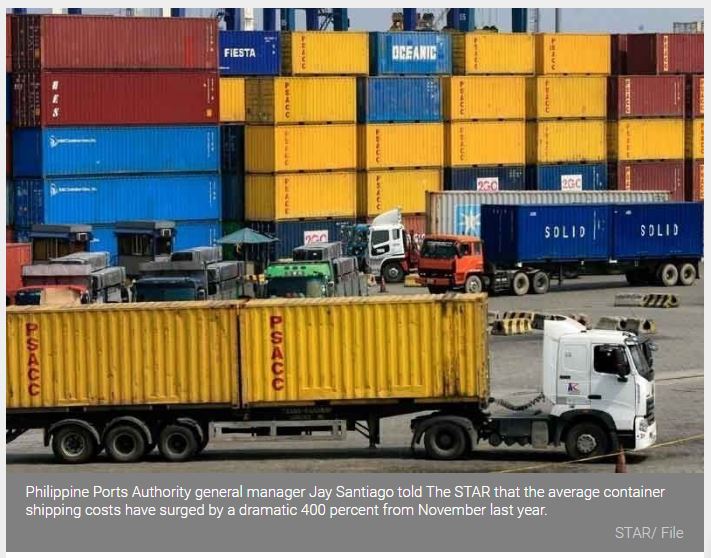Philippines: Soaring shipping rates to raise import costs
MANILA, Philippines — Prices of imported goods may go up, while exports may face delays as shipping rates continue to soar due to container shortages and strong demand.
Philippine Ports Authority general manager Jay Santiago told The STAR that the average container shipping costs have surged by a dramatic 400 percent from November last year.
From $2,000 in November 2020, Santiago said the shipping cost for one 40-foot shipping container now costs over $9,000.
Association of International Shipping Lines Inc. president Patrick Ronas said the current freight rates have never reached such a level in the past.
He said freight rates have increased to a certain degree due to the demand for space on mother vessels that carry exports to major markets like the US, Europe and the Middle East.
The shipping rates for moving around Southeast Asia, however, remain steady, he said.
“Any industry for that matter that requires imported materials will definitely be paying a higher price this time around as the freight rate increases, while exporters, where the freight is usually paid for by the buyers, may see some delays as buyers negotiate their freight rates,” Ronas told The STAR.
“Current freight pricing does not seem to work as we are fighting for space in the transhipment hubs and costs are accumulating for carriers when cargo are rolled over in these ports,” he said.
Michael Ricafort, chief economist at Rizal Commercial Banking Corp., said higher shipping costs worldwide could add to the prices or passed-on costs of the country’s various imports.
He said this could increase the prices of imported goods and could also lead to some uptick in inflation.
“However, softer economic recovery/conditions/overall demand due to the COVID-19 pandemic could reduce the pricing power of some businesses/manufacturers that could eventually absorb some of the increase in shipping/import costs, thereby could lead to narrower profit margins and could eat up to their net income/profits,” Ricafort told The STAR.
Fitch Ratings is expecting spot freight rates to remain high in the short term, which it said would flow through to contracted rates for the year.
However, Fitch Ratings said it considers the current rates unsustainable in the medium term, noting that the sector is susceptible to rate volatility and risks of weak economic recovery and trade protectionism.
Fitch said container box shortages and port congestions due to pandemic-related operational disruptions have extended container ships’ turnaround times, further increasing freight rates.
It said a usually quiet period during the Chinese New Year could have eased some congestion, but demand remained strong as China maintained its production levels.
“The ongoing virus outbreaks in many regions and mobility restrictions are likely to keep freight rates abnormally high in the short term,” it said.
Fitch said these higher-than-usual spot rates would translate into higher contract freight rates in the ongoing contracting season.
“However, we view rate volatility as an inherent sector risk and we expect rates to reduce once supply disruptions related to the pandemic are addressed,” it said.
At present, Ronas said there are still cargo yet to be carried on from the transhipment ports.
“The Chinese New Year just passed a couple of weeks back and usually demand for shipping space from China eases at these times, but we have yet to feel the effect on the space on the mother vessels,” he said.
“We should see more in the coming months if the volumes start easing off. Lines will then recalibrate pricing should there be changes to the volumes. Supply and demand is always at play,” Ronas said.
Ronas said the government could help only by trying to increase the export volume as the Philippines is a highly imbalanced trade, it imports more than it exports.
For every three containers that comes in loaded into the Philippines, Ronas said only one container is loaded for export, while the other containers are moved out as empty.
“Government must help our exporters grow their business and we should strengthen our research and development to come up with new products to sell in the global market,” he said.
Source: https://www.philstar.com/business/2021/03/01/2080985/soaring-shipping-rates-raise-import-costs


 Thailand
Thailand




